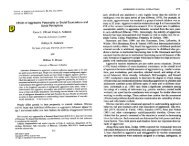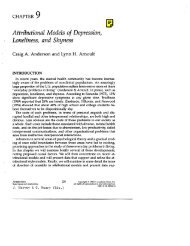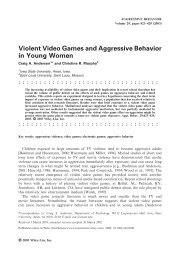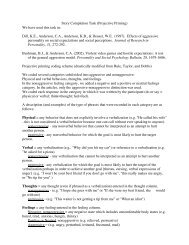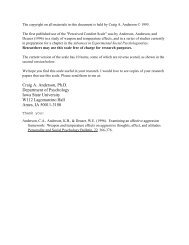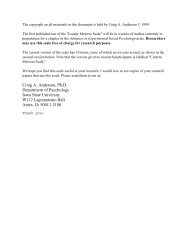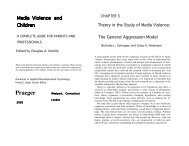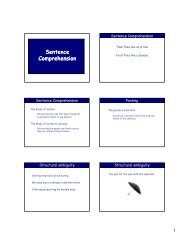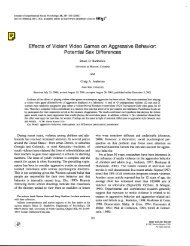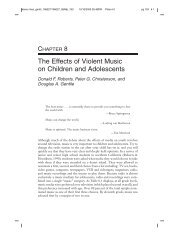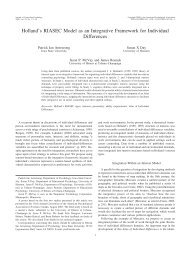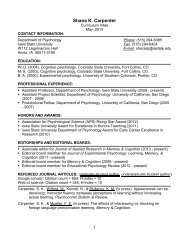The General Aggression Model: Theoretical Extensions to Violence
The General Aggression Model: Theoretical Extensions to Violence
The General Aggression Model: Theoretical Extensions to Violence
Create successful ePaper yourself
Turn your PDF publications into a flip-book with our unique Google optimized e-Paper software.
246 DEWALL, ANDERSON, AND BUSHMAN<br />
Figure 1. <strong>General</strong> aggression model.<br />
ing these forms of violence and even nonviolent<br />
behavior. Applying GAM <strong>to</strong> aggression that<br />
occurs outside the labora<strong>to</strong>ry not only adds <strong>to</strong> its<br />
explana<strong>to</strong>ry power, but it also enhances the external<br />
validity of its predictions.<br />
Psychologists have proposed a variety of theories<br />
<strong>to</strong> understand why people sometimes behave<br />
aggressively. Some examples include frustration–aggression<br />
theory (Dollard, Doob,<br />
Miller, Mowrer, & Sears, 1939), socioecological<br />
models (Heise, 1998), cognitive neoassociation<br />
theory (e.g., Berkowitz, 1989), social learning<br />
theory (e.g., Bandura, 1973; Mischel &<br />
Shoda, 1995), script theory (e.g., Huesmann,<br />
1986), excitation transfer theory (e.g., Zillmann,<br />
1983), and social interaction theory (e.g., Tedeschi<br />
& Felson, 1994). Each theory offers crucial<br />
insight in<strong>to</strong> understanding specific reasons why<br />
people behave aggressively. Yet, these minitheories<br />
do not provide an overarching framework<br />
for understanding human aggression and<br />
violence.<br />
GAM integrates minitheories of aggression<br />
in<strong>to</strong> a single conceptual framework. In so doing,<br />
GAM provides a more parsimonious model of<br />
aggression than other theories do, explains aggression<br />
that occurs because of multiple motives,<br />
and offers empirically validated insights<br />
in<strong>to</strong> ways <strong>to</strong> reduce aggression, including how<br />
<strong>to</strong> stunt the development of aggressive tendencies<br />
over time. It is the only social–cognitive<br />
model that explicitly incorporates biological,<br />
personality development, social processes, basic<br />
cognitive processes (e.g., perception, priming),<br />
short-term and long-term processes, and<br />
decision processes in<strong>to</strong> understanding aggression.<br />
<strong>The</strong>refore, GAM offers scholars a framework<br />
from which <strong>to</strong> derive and test hypotheses<br />
regarding aggression, a framework that is more<br />
expansive than any other social–cognitive<br />
model. One major focus of the present article is<br />
<strong>to</strong> show how GAM can also increase our understanding<br />
of more extreme forms of physical<br />
aggression that occur outside the labora<strong>to</strong>ry—<br />
violent behavior.<br />
GAM emphasizes three critical stages in understanding<br />
a single episodic cycle of aggression:<br />
(1) person and situation inputs, (2) present<br />
internal states (i.e., cognition, arousal, affect,<br />
including brain activity), and (3) outcomes of<br />
appraisal and decision-making processes. A<br />
feedback loop can influence future cycles of<br />
aggression, which can produce a violence escalation<br />
cycle (Anderson, Buckley, & Carnagey,<br />
2008; DeWall & Anderson, 2011). Several articles<br />
provide further insight in<strong>to</strong> these basic<br />
tenets of GAM (Anderson & Bushman, 2002;<br />
DeWall & Anderson, 2011).<br />
Applications of GAM<br />
GAM has received consistent support as a<br />
general model of aggression (for reviews, see<br />
Anderson & Bushman, 2002; DeWall & Anderson,<br />
2011). Although it was tested primarily<br />
using labora<strong>to</strong>ry aggression experiments, it can<br />
also be applied <strong>to</strong> aggression in the “real world”<br />
outside the labora<strong>to</strong>ry. Before we go further,<br />
however, we need <strong>to</strong> define the terms aggression<br />
and violence. We define aggression as any<br />
behavior intended <strong>to</strong> harm another person who<br />
does not want <strong>to</strong> be harmed (e.g., Anderson &<br />
Bushman, 2002; Bushman & Huesmann, 2010).<br />
We define violence as any aggressive act that<br />
has as its goal extreme physical harm, such as<br />
injury or death (e.g., Anderson & Bushman,<br />
2002; Bushman & Huesmann, 2010).<br />
In this section, we include several novel extensions<br />
of how GAM can inform understanding<br />
and research investigating intimate partner<br />
violence, intergroup violence, impact of global<br />
climate change on violence, and suicide. We<br />
chose these <strong>to</strong>pics for two reasons. First, each<br />
<strong>to</strong>pic applies <strong>to</strong> phenomena that occur outside<br />
the labora<strong>to</strong>ry, thereby increasing the explana<strong>to</strong>ry<br />
potential of GAM and the external validity<br />
of its predictions. Second, each <strong>to</strong>pic relates <strong>to</strong><br />
phenomena that occur relatively frequently in



